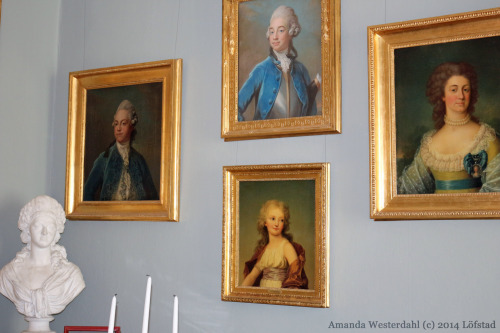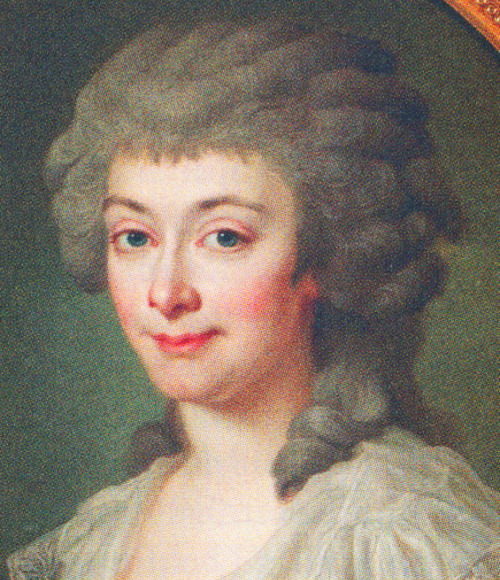#sophie piper
Framed portraits at Löfstad castle in Norrköping, Östergötland, Sweden.
The top portrait shows Axel von Fersen the younger (1755 - 1810) at age 14.
The left portrait shows Adolf Ludvig Piper (1750 - 1795).
The right portrait shows Sophie Piper née von Fersen (1757 - 1816), younger sister of Axel von Fersen.
The bottom portrait shows Marie Thérèse Charlotte, (1778 - 1851) the eldest daughter of Marie Antoinette.The bust in the left corner is of queen Marie Antoinette of France, I recently found out. This further shows the deep feelings shared between the queen of France and the von Fersen family.
Post link
Book review; “Barnbruden” (”The Child Bride”), by Anna Laestadius Larsson.
“It is 1774 and the royal flagship Sofia Albertina is approaching the Swedish coast. Aboard is Hedvig Elisabeth Charlotta, fifteen years old and the youngest royal bride in swedish history.
The popular noble lady Sophie von Fersen silently curses her mother who has forced with her on the journey. She does not want to attend to a stubborn german brat. In her fantasies she is at a ball in the arms of prince Fredrik.
In Stockholm king Gustav III and his court prepares a grand welcome. The expectations of the girl are high. She is to marry the king’s brother Karl and give the country the heir they’ve long awaited.
And far below the castle’s beautiful parade apartments the Pottiechild awakes - the mute girl who tends to other’s shit.”
I personally tend to read more during the summer than any other time of the year, so this year I finished this book in just 5 days. Not only because it had a good flow, but because it never ceased to be exciting. And with the great lack of swedish period dramas, this book is a jewel.
The book follows the perspective of Hedvig Elisabeth Charlotta, duchess of Södermanland and later queen of Sweden; Sophie von Fersen, the sister of the famous Axel von Fersen; and Pottungen (’the Pottiechild’), a fictional 10- year old girl who tends to the aristocrats’ chamber pots. A few other characters also narrate the story, but it is these three who are the main focus of the story, whereas the others simply serve a short cameo to fill in the dots.
It is interesting to follow the thoughts of these women, or at least as Laestadius Larsson puts them. The story is largely based on the diary and correspondence of Charlotta, but L. L admits that certain changes and liberties have been taken, which is of course common when it comes to writing about historical people like this. However, certain details stand out to me in the historical context it is meant to represent; just as an example, the author seems to have misunderstood the intentions of Axel von Fersen senior when he refused Sophie a marriage to prince Fredrik, and I disapprove of how Gustav III’s marriage to queen Sofia Magdalena is represented.
But these are just details that can be overlooked with the otherwise nearly flawless picture L.L paints of 18th century Sweden. The class differences and contemporary political tensions are well explained, all the while woven into an entertaining and Coppola-styled story.
While this book is sadly only available in swedish at the moment, I do recommend it - if not for the historical accuracy, then for the romantical affection Charlotta shows Sophie in her letters and the three-dimensional represantation of Axel von Fersen and his contemporaries.
Post link
The four children of Count Fredrik Axel von Fersen and Hedvig Catharina de la Gardie. All siblings held high positions within the swedish court, due to their father’s position as leader of the aristocratic party.
Hedvig Eleonora (von Klinckowström) von Fersen, 1753 - 1792, was described as reserved and disliked the court life, but accepted a position as lady in waiting to queen Sofia Magdalena for her husband’s sake. She was close friends with king Gustav III, but was one of few who dared to disobey his orders. It’s said that the king demanded everyone at court to partake in the gambling games, but when Hedvig refused he did not object.
Hans Axel von Fersen, 1755 - 1810, is without a doubt the most famous of the siblings. Predestined to inherit his father’s titles and goods, he made a name for himself during his Grand Tour in Europe, as well as during the American Revolution, Gustav III’s Russian War and later, the French Revolution, where he struggled to rescue Louis XVI and Marie Antoinette, who he is rumoured to have had an affair with. He was brutally murdered by a mob following a false accusation that he assassinated the swedish crown prince.
Eva Sophie (Piper) von Fersen, 1757 - 1816, is perhaps the second most famous of the four. Her affair with the swedish prince Fredrik Adolf was ended by her disapproving parents when she was unhappily married to Adolf Fredrik Piper. Over the years she formed an intimate (perhaps sexual) relationship with queen Hedvig Elisabeth Charlotta, who would dedicate her memoirs to her. Sophie was accused for the same assassination as her beloved brother Axel, but was protected from the mob by Charlotta.
Fabian Reinhold von Fersen, 1762 - 1818, became officer and politician at the swedish court. Just like his brother and sister, Fabian also had an intimate relationship with queen Hedvig Charlotta, and is rumored to have fathered a child which she miscarried. And just like his siblings, he was accused of involvement in the death of Crown Prince Karl August in 1810, but managed to escape the funeral procession where his brother was murdered. He resigned from his court position that same year, most likely in respect to his brother.
The von Fersen- line ended with Fabian’s two children, Axel and Hedvig, in 1839 and 1879.
Post link






